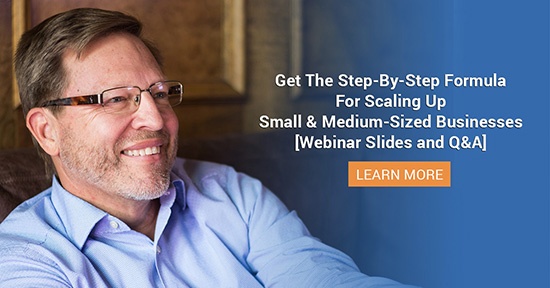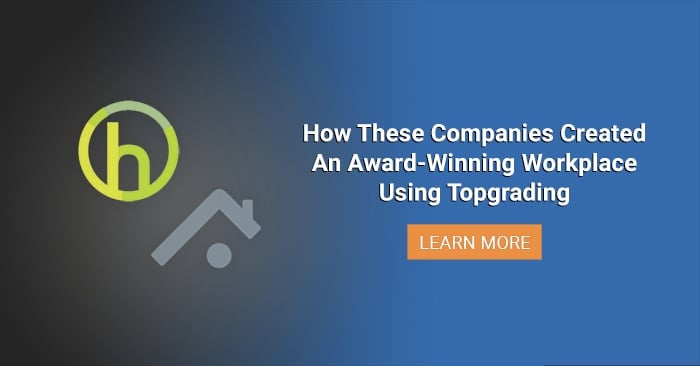Get The Step-By-Step Formula For Scaling Up Small & Medium-Sized Businesses [Webinar Slides and Q&A]

On November 7 we ran a live webinar for CEOs & Executives from the mid-market companies who are determined to scale up in 2018.
Verne Harnish shared his proven frameworks and the step-by-step formula, which you can now access below, along with some extra materials. Check out the webinar slides and Q&A.
Here are the webinar slides:
...and here's the Q&A:
1. What are the biggest barriers for successful implementation of scaling up model?
There are three that we mentioned and the first is leadership development. You gotta teach people how to do this stuff. We didn't learn it in school, even the topic of delegation. I have a whole MBA and we never once discussed what are the practical things you've got to do if you're gonna delegate properly. So that's the kind of education that's necessary, so that's why it's number one as a barrier.
I'd say number two is market timing. Bill Gross looked at this at Idea Lab. He grew 100 companies inside Idea Lab and funded about the same amount, and he said, "Look, the market can make you look smart or make you look stupid." Right now if you're in Fintech or Blockchain, it's why my wife's doing the Blockchain initiative this week. It's the hot thing; it's where the internet was two decades ago. If you're too early, hopefully you can hang on until you become popular and if you're too late, I would pivot and go do something else.
So I think those are the two big constraints. The rest that are detailed around people, strategy, execution, and obviously cash. And clearly cash I think is one that's perceived but as we teach in the course we're a big fan and you actually have created a masterclass with them. We're big fans of John Mullin's customer funded business, the London Business school professor and I really do think, like Elon Musk, Elon needed four billion and he got it by getting 400,000 customers and put down a thousand dollar deposit. That's an interest-free, equity-free loan. John did the same thing using bank debt. He didn't have to put a penny of his own equity in to rolling up those call centers.
So we outline a lot of really practical ways that you can increase your own internally generated cash, which is what Michael Dell had to do when he got stuck in order to scale up. So those I'd say are some of the general areas.
2. How can you implement effective meetings like the daily huddle and all that, if your company is virtual? You see our company works mostly from home and we've got people with all time zones in the US, so what suggestions do you have on having effective daily huddles or meetings if you're remote?
Well I'm telling you, this used to be hard, but with the technologies today, the conference lines, just put everybody on a phone call. Our meetings are done remotely as we've got people hanging from Portland to Hyderabad with 12.5 time zones in between. The key is just to remain consistent. Same time, same bat channel. Start right on time so people can trust, and what you don't want to do is have half the team standing around one of those conference phones and the other half on the phone. Just get everybody on the phone and connect, even if they're there in the office together. Keep the same modalities.
We have a client that we've had for years, they actually run the entire back end for Visa international and the leadership and sales team are out there in San Francisco right next door to Visa, but all of their technology team is in Calcutta, India and they've got some beautiful meeting technology. They literally do a stand up. I've been on both ends and watched it. That's how they stay connected doing kind of mission critical work that's necessary if you're on the back end of Visa International.
3. How can your communication change in a company that grows? What can I do as a manager to ensure that communication doesn't change or if it changes, change in a positive way as the company grows?
Well a couple of things, routines we've talked about. Mark Zuckerberg from almost the beginning has his Q&A with Mark. He takes an hour every Friday and opens it up. People can show up physically or get on Facebook and communicate with him. Michael Dell did it through an email that he sent out once a week. Greg Brenneman at Continental Airlines did it through a voicemail message that he put out. The Google boys have what's called TGIF, Thank God It's Friday, but now that meeting is every Thursday. So there's something about just, and it's me putting out my weekly insights every Thursday. There's something about the consistency of communication, and I do think it has to be at least weekly, is the thing that we're learning from all those that have been able to scale pretty rapidly.
So I think that's number one. And then number two, I kind wish you'd asked a little bit different question, but what kills this meeting rhythm is generalities. If you're not sharing specifics in the daily huddle, in the weekly meeting, and in your communications. If you just kind of general blah, blah, blah, blah, blah, people are gonna be bored out of their minds. And so hopefully I gave you very specific examples and stories that you're gonna remember versus the kind of general theoretical lessons that we could share. And that's what you've gotta make sure with your communication, that I'm sharing names, and times, and amounts and not just say, "Well, I'm working on a sales proposal." I want to know who it's for, how much it is, and it's by hearing that, that I begin to put the patterns and trends together.
So, specifics, frequency and routine I think are critical.
4. How do you manage people's resistance to change and get them to buy in? I see they're very excited when we talk about vision and all that, but we never get to execution. They seem to be too overwhelmed with the current reality. How do you keep them pumped?
Well that's why in our strategy session we took apart the word strategic planning and strategic thinking. And John was clear at AppleTree, it was really him, he made those handful of strategic decisions, but you've got to then let everyone else be involved in execution planning. The best way to create ownership is let people be involved in putting those plans together and that's part of what our process is designed to do, to get that kind of involvement and kind of build the plan from the ground up once you've set what the key targets are that you want to point the company to.
And then I think the second thing is just over-communicate. That's how you deal with all kinds of change within any organization. So if you get to kind of create it and then just keep me informed with what's going on, which again is why these top companies communicate every week about what they're thinking, what's up, so that you can maintain the buy in. That's how you can manage the change management process.
5. We're a small company, staff of ten. Are we too small to use this framework?
No, you guys saw my wife. We sat down and did a vision summary day one, four months before our first revenue. So now the tools are really critical as you get to 40 employees. You get to that point where you don't know everyone's name. Sam said, "I got 50, 60, 70 employees and it really gets dicey at that point." And that's why it's even more important if you can get some of these fundamental habits and routines in place at ten, then it's gonna be much easier as you bring people in to have them in place when you do hit 40 or 50.
6. If a start-up doesn't have the staff to delegate functions, what process do you use to decide what functions to hire first?
Well first of all, someone has to do all those things, even if you're wearing multiple hats. I was head of a company and day one I was running everything and got bookkeeping off my plate. In this day and age, you can actually outsource a lot of those. We still outsource our IT to a company out of Hyderabad, India, and we're still with a PEO, professional employee organization, that's able to handle a lot of the technical HR issues that we don't really want to have anybody on staff full time to handle. And so in this gig economy that we've got, there's a lot of ways you can get talent. I remember Bill Becker I was just chatting with. Bill brought in a professional CFO for just a day a week until he scaled to bring her on five days.
So those are different ways of kind of filling those holes on your form.
7. So we can't hire an ace team because we cannot pay them what they deserve and we're stuck with good people, but as a CEO, I still do everything myself. What's your suggestion to higher up and get better people?
Well, so I've got a great story in the book of Scott Nash of Mom's Organic Market. He's got a supermarket chain, and he's trying to hire a top-notch CFO in a marketplace Washington DC area where there was zero unemployment even through the downturn, and people make a fortune. The key is to sell vision and the future. That's how you commit somebody to buy your company for a lot of money, and that's how you bring somebody on. In his case, he ended up with 40 applications in just a week of just top-notch talent using the process I described in the book and I really go into detail in the online course.
And then he ended up with a woman, Penny, who literally took a pay cut in half because she bought into where Scott was taking the company and she's obviously been able to make beyond that now that they've scaled 10x. So, that's why it's important to be very clear about what that vision summary is.
And by the way, I should go back and mention, a lot of people misunderstand. Again, I get into detail on this, the definition of an A player. An A player is the best person you can afford, and the reality is most of us don't know how to hire properly using the Topgrading methodology. And what Topgrading finds is if you're down to the final three candidates, it's not that you didn't hire a good person, but you probably turned away a better person and that can really add up because we have such biases if you don't use a rigorous methodology.
So, Scott Nash, he won't hire someone to be a cashier to stock his shelves at night or even bag groceries without going through a two hour topgrading interview because he wants to make sure if he's down to four or five folks who are going to bag groceries, he gets the right one of the five. I'm telling you, you don't have to gain a lot for every hire to make a huge difference, which it has in Scott's company. Again, he's not Apple or Microsoft or Google, this guy runs small organic supermarkets. It's scaled now pretty significantly on the Northeast part of the United States.
8. How do you get the full team laser focused? What's the one thing you use to keep your team focused?
Well I think it's what we saw with Jean's example, Jean Brown with City Bin. You know you've got to set a stake in the ground. Without a vision, the people perish, and it's hard to attract talent if there isn't that compelling vision. It's how I got Regis McKenna to agree to consult with me for free. And this was a guy that was helping Apple and Genentec and Intel. And then you gotta break it down to that kind of small, bite-sized piece. This is why we're trying to do our jobs, this is the one thing we're gonna get done over the next 90 days. And it's the thing that Tom Meredith taught Michael Dell and he did it as he scaled up Dell and Jean Brown's done it with City Bin.
And then again, I sound like a broken record, but every one of these CEOs, it's why this program I think has won so many awards in YPO. It's the only program where the YPO brings their entire team. Dr. Mok with Allure Medical Spa's, we just did a big Huffington Post piece on him, the guy had no cash to expand, came to our program, immediately got his people engaged and found 300,000 a month in savings, and with other changes they made, now they're opening a spa every 90 days. What you'll notice is that our summits and in training, he'll bring 15 of his team. And so I go back, it's leadership development. If you want to grow faster, you gotta grow your people.
That's why it was Henry McGovern, final story who endorsed the front of my book, he's now the largest European restaurant owner in the world. We built this online course for him because he said, Verne, you gotta come to Poland and do some training for us. We believe in these tools. Twenty years ago when he was just a student of mine opening his first Pizza Hut in Poland. And I knew after that I wasn't going to be back in Poland any time soon, and I’m not going to be able to get any of the other thought leaders like, Victoria Medvec on negotiations, or the folks at Topgrading over there. And I said, "Alright Henry, I'm gonna do this for you. I'm gonna put these courses online, and I'm gonna learn how to do it right so that your people can implement this stuff and not just be entertained," and Henry has been one of the biggest users of our tools.
By the way, he just bought Starbucks Germany and Starbucks allowed him to do it because he runs better than almost anybody else and as he said, on his 20th anniversary, the reason he's been so successful is because he's always seen himself first as a training company and then last as a restaurant company.
And I like to leave people with that idea that Steve Jobs figured out how to do something every two years, what he learned when he was at Pixar. And I always ask my audiences, he knew he was dying, and what was his last project? What are you gonna leave behind that's gonna guarantee that your baby not only survives but thrives? And it was Apple University. It wasn't a product, it wasn't a service, it was developing the future of the company.
So that's been our mission. How do we create this university online, so you can have access to world-class talent, and you can afford it. Most of us don't have the budgets that Apple does to put in your own corporate university, and so it's very missional for me as you know again.
Are You Ready to Stand on the Shoulders of Giants?
If you’re ready to take your business further and succeed, I invite you to stand on the shoulders of today’s industry leaders by joining Business Growth Lab — a series of free webinars about business topics with top business experts and thought leaders, including many of the people I mentioned here and myself.
During your journey with us you will learn about new opportunities about scaling your business, developing processes and finding best ways to win new markets.1
Subscribe to Business Growth Lab for free << here >>



